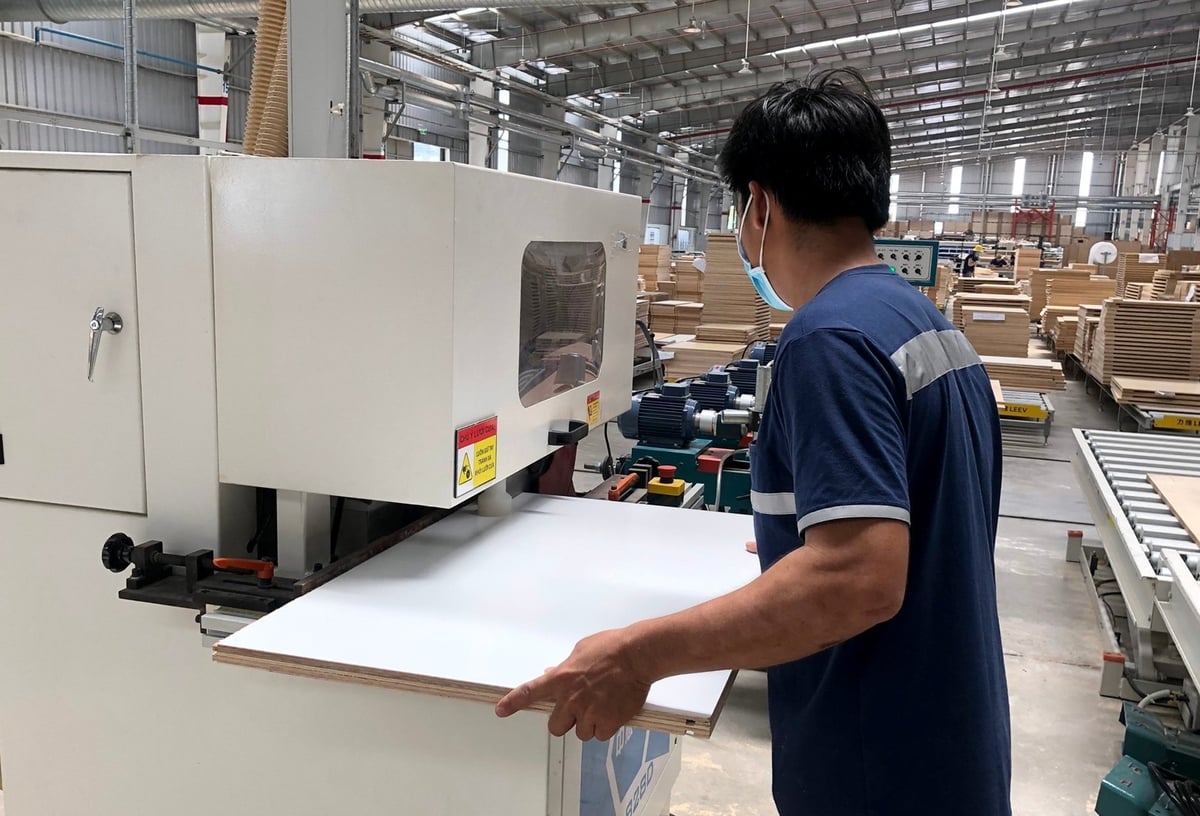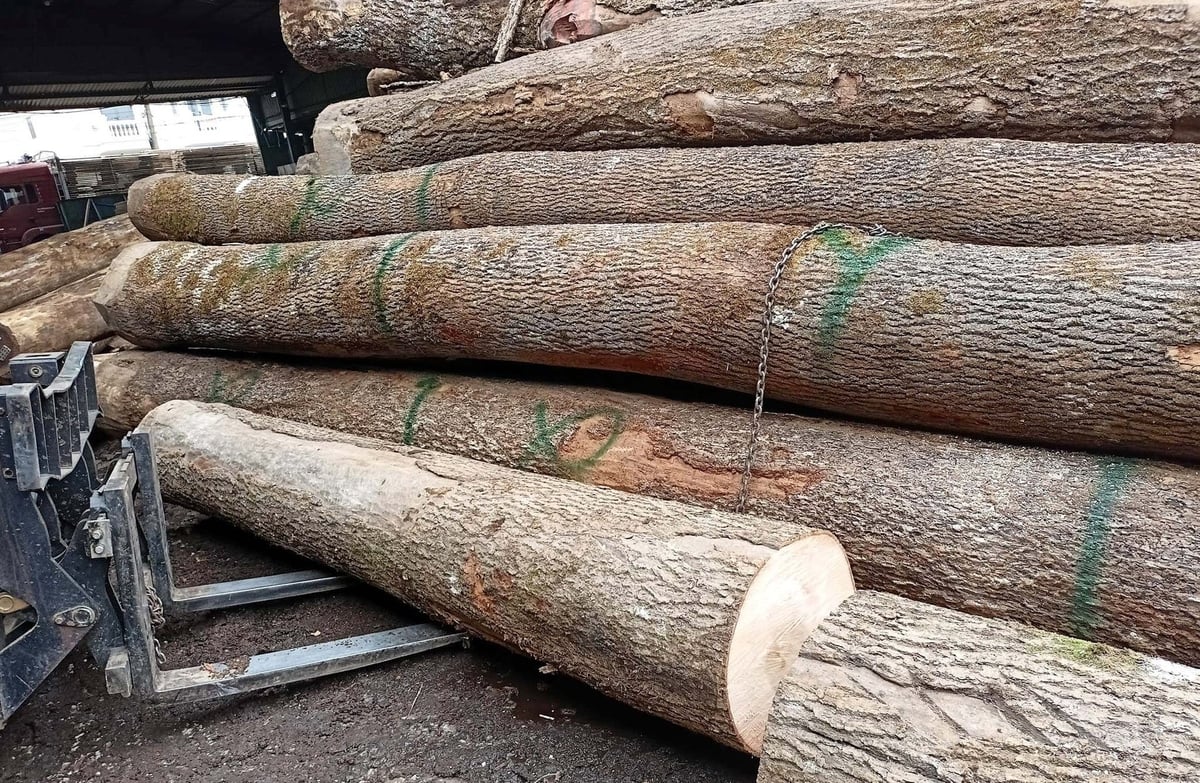December 21, 2025 | 08:02 GMT +7
December 21, 2025 | 08:02 GMT +7
Hotline: 0913.378.918
December 21, 2025 | 08:02 GMT +7
Hotline: 0913.378.918

Producing wooden products for export at a factory in Binh Duong. Photo: Son Trang.
Vietnam's wood and wood product exports to the United States have maintained their growth, despite concerns regarding potential reciprocal tariffs. April saw a 4.1% year-over-year increase in exports to the United States, which totaled USD 799 million. The total export value to the United States during the first four months of 2025 was USD 2.9 billion, a 10.3% increase from the same period in 2024.
At present, the United States is responsible for over half of Vietnam's total wood and wood product exports, a proportion that is slightly higher than that of the previous year (54.4% versus 54.1%). These figures indicate that Vietnamese exporters are accelerating shipments to the United States in response to the temporary suspension of tariff enforcement by the U.S. government. They also emphasize Vietnam's ongoing dependence on the American market for wood exports.
Adapting to alternative markets following the implementation of the tariff will be challenging due to the U.S.'s dominance in Vietnam's wood export portfolio. Designing products for the United States may not be appropriate for other markets, as each market has its own unique standards and preferences for wooden products. Furthermore, the vast size of the U.S. market makes it difficult for other countries to fully compensate for any lost demand.
Currently, wood companies are not only striving to optimize the flow of their products to the United States, but they are also anticipating that the tariffs will eventually remain within a manageable range. American importers are currently grappling with the challenge of locating substitute sources, as Vietnamese wood products comprise nearly half of all U.S. wood imports. This is particularly challenging given that China, the second-largest supplier, is already subject to high tariffs.
Vietnam is also prioritizing the procurement of raw wood materials from the United States in order to enhance the trade balance and demonstrate goodwill. Mr. Ngo Sy Hoai, Vice Chairman of the Vietnam Timber and Forest Product Association, has stated that American timber is experiencing export challenges to China as a result of the ongoing tariff disputes between the United States and China. As a result, Vietnam's increased imports of U.S. logs and sawn timber not only indicate cooperation but also contribute to the reduction of trade imbalances between the two countries.
Vietnamese exporters are also able to reduce the effects of reciprocal tariffs by utilizing U.S.-sourced timber for furniture exports to the American market. Mr. Do Ngoc Hung, Vietnam's Commercial Counselor in the United States, clarified that tariffs would only apply to the non-U.S.-origin portion of Vietnamese products that contains at least 20% U.S.-origin materials or inputs.
Statistics regarding imports corroborate this development. In the initial three months of 2025, Vietnam Customs reported that the importation of U.S. timber amounted to 191,000 cubic meters, with a value of nearly USD 79 million. This represents a 34.1% increase in volume and a 28.1% increase in value compared to the previous year.

Vietnam's wood industry is prioritizing the import of raw wood from the United States. Photo: Son Trang.
Many Vietnamese wood firms are resolute in their efforts to preserve their market position, despite the imposition of tariffs, as they recognize the ongoing significance of the U.S. market. Expanding B2C (business-to-consumer) sales directly to U.S. consumers through e-commerce platforms such as Wayfair and Amazon is one emerging solution.
Mr. Huynh Le Dai Thang, Director of Nghia Son Furniture Production and Trading Co., Ltd., disclosed that his business has been conducting business-to-consumer (B2C) transactions for more than three years. Currently, B2C accounts for approximately 10% of the organization's total export revenue.
The furniture segment on Amazon accounts for substantial sales volumes, as per Ms. Luu Thi Hue, Senior Account Manager at Amazon Global Selling Vietnam. Vietnam's total wood exports in 2024 exceeded USD 16.2 billion. Conversely, wood product sales on Amazon exceeded USD 14.2 billion during the two-day Prime Day event in July.
However, Ms. Hue advised that successful B2C sales on Amazon necessitate comprehensive preparation in the areas of financial capacity, competitiveness, personnel, and, most importantly, a long-term strategic vision for direct-to-consumer international retail.
Vietnam's wood industry is actively endeavoring to diversify export markets in addition to sustaining its U.S. presence. China, Japan, India, the United Kingdom, Canada, Australia, and the Middle East are among the most promising destinations.
Translated by Linh Linh

(VAN) The seafood industry is aiming for an export goal of USD 10.7 billion in 2025. However, resolving bottlenecks regarding data and green finance is an urgent requirement.

(VAN) Exports of ornamental fish generate nearly USD 15 million annually for Ho Chi Minh City, affirming the sector's position as a distinctive economic component of the city's modern urban agriculture structure.

(VAN) Lang Son agricultural products are upgrading planting-area standards, increasing deep processing, and expanding linkages to move toward sustainable exports.

(VAN) Despite numerous challenges, Vietnam's key seafood products are maintaining strong momentum, setting the stage for full-year exports to potentially reach USD 11 billion.

(VAN) The signing of a protocol between Viet Nam and China on the export of fresh jackfruit represents a significant milestone in agricultural trade cooperation between the two countries.

(VAN) On November 27, the Ninh Binh Department of Agriculture and Environment and the Institute for Green Growth Research organized a training course on greenhouse gas inventory for businesses.

(VAN) China’s cooking oil is suddenly flooding into India. It all comes down to a soybean surplus that Beijing doesn’t quite know what to do with.